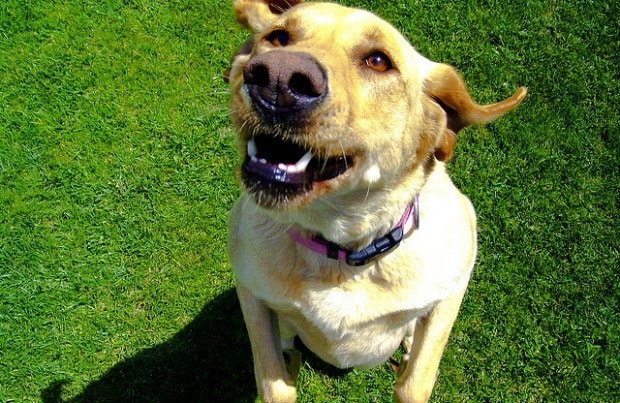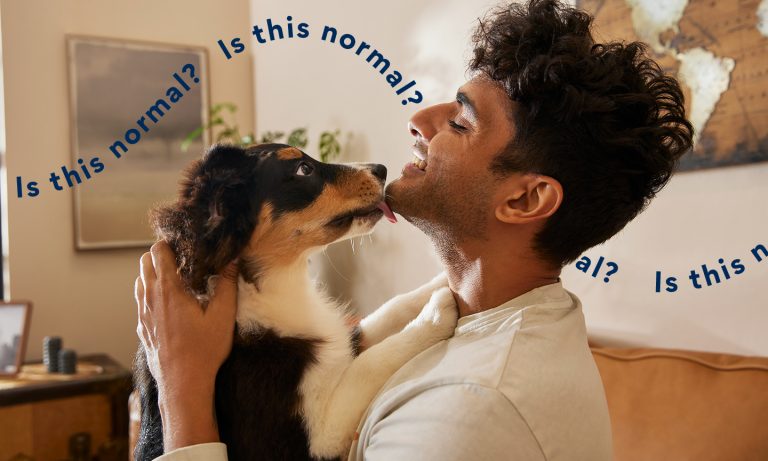Sometimes our beloved best friends can act a little …rude. Dogs don’t understand the finer points of negotiation, so instead of gently asking for what they want, they often take a more direct and pushy approach. You don’t have to live with your dog’s “assertiveness,” though. Here are some common overbearing canine behaviors and how to deal with them.
1. Jumping up: This behavior tops the list because it seems that nearly every dog does it! Jumping up is an unappreciated and pushy way of greeting people or asking for attention. Why do dogs do it? Because it works! The dog who jumps up when his people come home or when friends visit is rewarded by attention, even if the attention he gets is grumpy.
A quick way to short circuit the behavior is to ignore your dog when he jumps up at you for attention, and then acknowledge him when he’s doing anything other than jumping, like standing near you, or better yet, sitting. You can use a tether to help keep your dog from jumping up on guests. Leash him to a heavy piece of furniture near the entry way so that he can interact with guests, but they can step away from him if he starts to jump on them.
2. Barking: Attention-seeking barking is different from guard dog barking. The guard dog sees or hears something that sets him off, while the attention-seeking barker is probably bored and looking for acknowledgement.
The best way to mute this type of barker is to take away the power of the bark by ignoring it. If your dog barks at you when he wants his dinner, step away from the bowl! If you continue making his meal he’ll understand that barking works to get him what he wants. If you stop meal prep until he’s quiet, he’ll soon figure out that silence makes his food appear.
3. Thrusting dog toys at you:Pushy dogs know that if they try hard enough, they usually get what they want. The fetch-driven dog might drop his slobbery ball in your lap over and over until you finally acquiesce and toss it for him. But doing so drives home that point that persistence pays off, and before you know it you’ve got an unrelenting toy-pusher on your hands.
Rather than giving in to the demanding player (even though this is probably the least offensive of the pushy behaviors), walk away, and then instill some rules the next time you play together. Ask your dog to sit before you throw the ball and drop when he brings it back, have a clear “game over” signal for when you’re done, and blow off any pushy entreaties in the future.
4. Pawing: There’s a common theme when dealing with pushy canine behaviors: ignore them whenever possible. Pawing for attention usually works for the dog because we can’t help but acknowledge it – it’s kind of cute! (No lie: my dog Olive is pawing me as I write this, and it is adorable.)
If your dog’s heavy paw swipes are uncomfortable or annoying, get up and move away from him when he does it. Better yet, start moving before his paw actually makes contact. Then make sure to acknowledge your dog when he’s near you and not trying to rake his claws down your leg!
5. Begging: It starts with an adorable pair of pleading eyes and morphs into a demanding behavior that interrupts every meal. With begging it takes two to tango, as your dog can’t access what’s on your plate without help from you. It’s not easy to admit it, but you created this monster!
If your dog whimpers or pesters you for food at dinnertime, try giving him something to focus on instead of your meal. A tasty bone or treat-stuffed Dog interactive toys (you can even stuff the toy with a little bit of his dog food) will keep him happily occupied and allow you to clean your plate without interruption.
Image: Tom Rydquist via Flickr

Victoria Schade is a dog trainer, author & speaker who has contributed to The Washington Post, Martha Stewart, and other publications.
Share:











